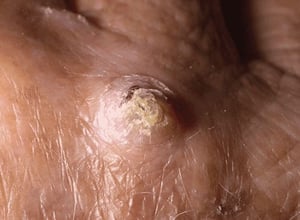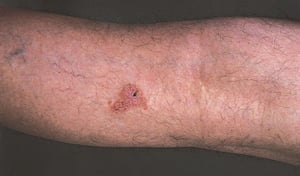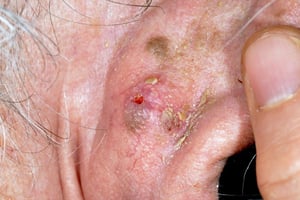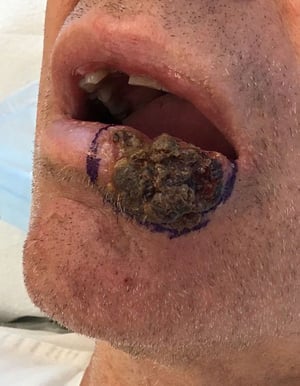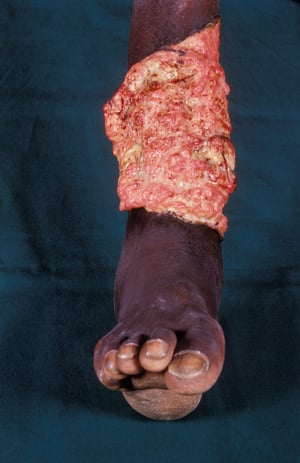|
Squamous Cell Carcinoma ByVinod E. Nambudiri, MD, MBA, EdM, Harvard Medical School Joseph F. Merola, MD, MMSc, UT Southwestern Medical Center Reviewed/Revised Modified Dec 2023 v21367234View Patient Education Squamous cell carcinoma is a malignant tumor of epidermal keratinocytes that invades the dermis; this cancer usually occurs in sun-exposed areas. Local destruction may be extensive, and metastases occur in advanced stages. Diagnosis is by biopsy. Treatment depends on the tumor’s characteristics and may involve curettage and electrodesiccation, surgical excision, cryosurgery, or, occasionally, radiation therapy. | | | | | | (See also Overview of Skin Cancer.) Squamous cell carcinoma is the second most common type of skin cancer after basal cell carcinoma, with 1.8 million cases annually in the United States (). It may develop in normal tissue, in a preexisting , in a patch of , or in a burn scar. People with light skin are much more susceptible to squamous cell carcinoma than people with dark skin. Reference1. Skin Cancer Facts & Statistics: Nonmelanoma skin cancer. Accessed September 25, 2023. Symptoms and Signs of Squamous Cell CarcinomaThe clinical appearance is highly variable, but any nonhealing lesion on a sun-exposed surface should be suspect. The tumor may begin as a red papule or plaque with a scaly or crusted surface and may become nodular or hyperkeratotic, sometimes with a warty surface. In some cases, the bulk of the lesion may lie below the level of the surrounding skin. Eventually the tumor ulcerates and invades the underlying tissue. Manifestations of Squamous Cell Carcinoma
Squamous Cell Carcinoma (1) This photo shows a hyperkeratotic skin-colored nodule arising on a sun-exposed area consistent with cutaneous squamous cell carcinoma.
Photo provided by Thomas Habif, MD.
Squamous Cell Carcinoma (2) This erythematous, irregular plaque on an extremity was diagnosed as squamous cell carcinoma on biopsy.
© Springer Science+Business Media
Squamous Cell Carcinoma (3) The appearance of squamous cell carcinoma is variable. These hyperpigmented, scaly lesions on the earlobe were diagnosed as squamous cell carcinoma on biopsy.
DR P. MARAZZI/SCIENCE PHOTO LIBRARY
Squamous Cell Carcinoma (4) This squamous cell carcinoma on the lip is highly keratinized; not all squamous cell carcinomas of the lip are as highly keratinized.
Photo courtesy of Gregory L. Wells, MD.
Advanced Squamous Cell Carcinoma (1) This photo shows squamous cell carcinoma manifesting as a large, ulcer-like area that, in its later stages, spread to other parts of the body.
DR M.A. ANSARY / SCIENCE PHOTO LIBRARY
Advanced Squamous Cell Carcinoma (2) This photo shows squamous cell carcinoma manifesting as a large, ulcer-like area that, in its later stages, spread to other parts of the body.
DR M.A. ANSARY / SCIENCE PHOTO LIBRARY
Squamous Cell Carcinoma (1) This photo shows a hyperkeratotic skin-colored nodule arising on a sun-exposed area consistent with cutaneous squamous cell carcinoma.
Photo provided by Thomas Habif, MD.
Squamous Cell Carcinoma (2) This erythematous, irregular plaque on an extremity was diagnosed as squamous cell carcinoma on biopsy.
© Springer Science+Business Media
Squamous Cell Carcinoma (3) The appearance of squamous cell carcinoma is variable. These hyperpigmented, scaly lesions on the earlobe were diagnosed as squamous cell carcinoma on biopsy.
DR P. MARAZZI/SCIENCE PHOTO LIBRARY
Squamous Cell Carcinoma (4) This squamous cell carcinoma on the lip is highly keratinized; not all squamous cell carcinomas of the lip are as highly keratinized.
Photo courtesy of Gregory L. Wells, MD.
Advanced Squamous Cell Carcinoma (1) This photo shows squamous cell carcinoma manifesting as a large, ulcer-like area that, in its later stages, spread to other parts of the body.
DR M.A. ANSARY / SCIENCE PHOTO LIBRARY
Advanced Squamous Cell Carcinoma (2) This photo shows squamous cell carcinoma manifesting as a large, ulcer-like area that, in its later stages, spread to other parts of the body.
DR M.A. ANSARY / SCIENCE PHOTO LIBRARY Diagnosis of Squamous Cell CarcinomaBiopsy Biopsy is essential. Differential diagnosisDifferential diagnosis varies based on the lesion's appearance. Nonhealing ulcers should be differentiated from pyoderma gangrenosum and . Nodular and hyperkeratotic lesions should be differentiated from keratoacanthomas (probably squamous cell carcinomas themselves) and verruca vulgaris. Scaling plaques should be differentiated from basal cell carcinoma, , verruca vulgaris, seborrheic keratosis, psoriasis, and nummular dermatitis (discoid dermatitis). Treatment of Squamous Cell CarcinomaUsually locally destructive techniques Treatment of squamous cell carcinoma is similar to that for and includes curettage and electrodesiccation, surgical excision, cryosurgery, topical chemotherapy (imiquimod or 5-fluorouracil) and photodynamic therapy, or, occasionally, radiation therapy. Treatment and follow-up must be monitored closely because of the greater risk of metastasis compared with a basal cell carcinoma. and includes curettage and electrodesiccation, surgical excision, cryosurgery, topical chemotherapy (imiquimod or 5-fluorouracil) and photodynamic therapy, or, occasionally, radiation therapy. Treatment and follow-up must be monitored closely because of the greater risk of metastasis compared with a basal cell carcinoma. Squamous cell carcinoma on the lip or other mucocutaneous junction should be excised; at times, cure is difficult. Recurrences and large tumors should be treated aggressively with Mohs microscopically controlled surgery, in which tissue borders are progressively excised until specimens are tumor-free (as determined by microscopic examination during surgery), or by a team approach with surgery and radiation therapy. Because tumors with perineural invasion are aggressive, radiation therapy should be considered after surgery. Metastatic disease is responsive to radiation therapy if metastases can be identified and are isolated. Widespread metastases do not respond well to chemotherapeutic regimens. For inoperable advanced disease or metastatic disease, programmed death receptor 1 (PD-1) inhibitors (eg, cemiplimab, pembrolizumab) are now an option.Metastatic disease is responsive to radiation therapy if metastases can be identified and are isolated. Widespread metastases do not respond well to chemotherapeutic regimens. For inoperable advanced disease or metastatic disease, programmed death receptor 1 (PD-1) inhibitors (eg, cemiplimab, pembrolizumab) are now an option. Prognosis for Squamous Cell CarcinomaIn general, the prognosis for small lesions removed early and adequately is excellent. Regional and distant metastases of squamous cell carcinomas on sun-exposed skin are uncommon but do occur, particularly with poorly differentiated tumors. Characteristics of more aggressive tumors include Size > 2 cm in diameter Invasion depth of > 2 mm Perineural invasion Location near the ear or vermilion border About one third of lingual or mucosal cancers have metastasized before diagnosis (see Oral Squamous Cell Carcinoma). Late-stage disease, which may require extensive surgery, is far more likely to metastasize. It spreads initially regionally to surrounding skin and lymph nodes and eventually to nearby organs. Cancers that occur near the ears or the vermilion border, in scars, or that have perineural invasion are more likely to metastasize. The overall 5-year survival rate for metastatic disease is 34% despite therapy. Prevention of Squamous Cell CarcinomaBecause squamous cell carcinoma is associated with ultraviolet (UV) exposure, a number of measures are recommended to limit exposure. Sun avoidance: Seeking shade, minimizing outdoor activities between 10 AM and 4 PM (when sun's rays are strongest), and avoiding sunbathing and the use of tanning beds Use of protective clothing: Long-sleeved shirts, pants, and broad-brimmed hats Use of sunscreen: At least sun protection factor (SPF) 30 with broad-spectrum UVA/UVB protection, used as directed (ie, reapplied every 2 hours and after swimming or sweating); should not be used to prolong sun exposure Key PointsSquamous cell carcinoma, because of its high frequency of occurrence and highly variable appearance, should be considered in any nonhealing lesion in a sun-exposed area. Metastases are uncommon but are more likely in cancers involving the lingual or mucosal surfaces; that occur near the ears, the vermilion border, or in scars; or that have perineural invasion. Treatment is usually with locally destructive methods, sometimes also with radiation therapy (eg, for tumors that are large, recurrent, or have perineural invasion). PD-1 inhibitors such as cemiplimab and pembrolizumab may be useful in patients with advanced or metastatic disease.PD-1 inhibitors such as cemiplimab and pembrolizumab may be useful in patients with advanced or metastatic disease.
Test your KnowledgeTake a Quiz!
Copyright © 2025 Merck & Co., Inc., Rahway, NJ, USA and its affiliates. All rights reserved.
Copyright© 2025Merck & Co., Inc., Rahway, NJ, USA and its affiliates. All rights reserved. (责任编辑:) |

